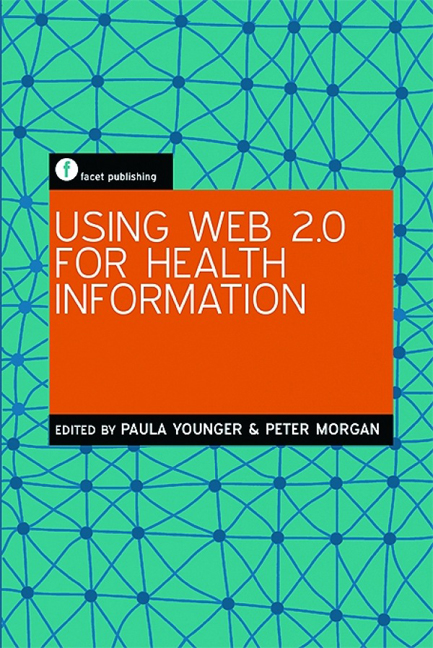Book contents
- Frontmatter
- Contents
- Preface
- Acknowledgements
- Contributors
- Glossary
- Introduction
- Part 1 The basics
- Part 2 Web 2.0 and the implications for health information
- Part 3 Web applications in health information provision: some practical examples
- Part 4 The future
- 14 Web 3.0 and health librarians: what does the future hold?
- 15 Conclusion
- Index
14 - Web 3.0 and health librarians: what does the future hold?
from Part 4 - The future
Published online by Cambridge University Press: 08 June 2018
- Frontmatter
- Contents
- Preface
- Acknowledgements
- Contributors
- Glossary
- Introduction
- Part 1 The basics
- Part 2 Web 2.0 and the implications for health information
- Part 3 Web applications in health information provision: some practical examples
- Part 4 The future
- 14 Web 3.0 and health librarians: what does the future hold?
- 15 Conclusion
- Index
Summary
Introduction
In a 2001 Scientific American article, Sir Tim Berners-Lee shares his vision for the world wide web which he believes will solve most of humankind's ‘most complex problems’ (Berners-Lee et al., 2001). In this chapter, we provide an update on the evolution of Web 3.0 and Berners-Lee's ideas for a Semantic Web – two separate terms that many believe are synonymous, while others dispute if they even exist. In addition, we reflect on what Web 3.0 means for health librarians and whether there are new roles for us in shaping its future.
Web 3.0 is more than semantics
A word of warning: both the Semantic Web and Web 3.0 lack clear definitions (see Glossary), yet these terms are widely and interchangeably used. For us, Web 3.0 refers to the third decade of the web and the Semantic Web is simply part of that; however, this interpretation is also disputed (Anderson and Rainie, 2010). The experts cannot agree on a name, a definition or whether Web 3.0 exists. What is important for librarians to remember is that Web 3.0 is not a whole new internet space but a group of trends that extends the web's functionality by:
• translating the web into a language that can be read and categorized by computers
• applying the technologies of the Semantic Web to improve how information is found
• creating a way to link to documents (‘to create linked data’) through artificial intelligence (AI) and machine-based reasoning
• integrating three-dimensional (3D), virtual and physical worlds into an immersive web experience.
Consider for a moment that the current web is evolving from Web 2.0 into a mobile and immersive medium (Lippincott, 2010). Part of the (r)evolution includes geolocation tools like Foursquare and virtual worlds like Second Life. But conceptually, the nextgeneration web or ‘web of data’ as articulated by Berners-Lee and others looks back to an earlier model of documentation by Paul Otlet in the early 20th century (Wright, 2009) and to bibliographic control by Melvil Dewey and Antonio Panizzi in the 19th century (Carpenter, 2002). For the cutting edge in organizing and linking important information, what's old seems new again.
The Semantic Web in progress
… semantics comes from the Greek to give signs, meaning, or to make significant. Semantics refers to aspects of meaning as expressed in language or systems of signs. (Giustini, 2007)
- Type
- Chapter
- Information
- Using Web 2.0 for Health Information , pp. 141 - 152Publisher: FacetPrint publication year: 2011



